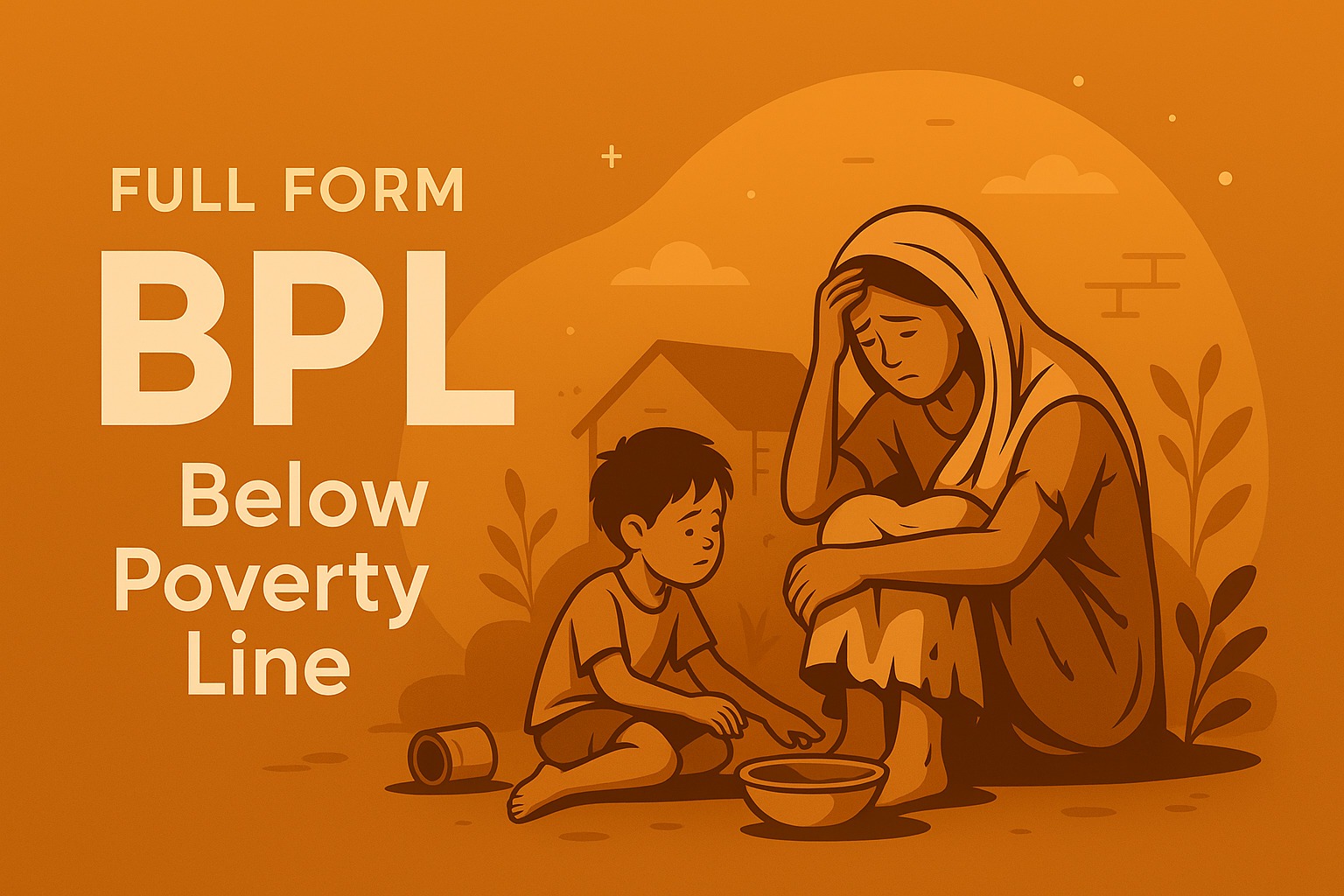Table of Contents
BPL Full Form: The full Form of BPL is Below Poverty Line. BPL is a benchmark set by the Government of India to identify families and individuals who are economically disadvantaged. These families qualify for various government subsidies, schemes, and welfare programs like food grains at low prices, free education, housing support, and more. However, the criteria for being classified as Below Poverty Line vary across states and regions, and are determined based on various socio-economic factors, not just income.

How is BPL Status Determined?
India uses different parameters for urban and rural areas to identify Below Poverty Line families. The most widely referenced method is based on a survey conducted in 2002, though many experts believe this data is now outdated.
- Below Poverty Line in Rural Areas
A family’s Below Poverty Line status is judged on 13 social and economic indicators. These include: Landholding, Type of house, Food availability, Clothing, Education levels, Employment type, Sanitation, Child status, Debt, Migration reason, Consumer goods, Income source, Literacy. Each indicator has a score ranging from 0 to 4. A family scoring 17 or fewer points out of 52 is considered BPL in rural areas.
- Below Poverty Line in Urban Areas
In cities, the evaluation is based on 7 indicators: Type of roof and floor, Access to clean water and sanitation, Education level, Employment type, Condition of children in the household
BPL Past Methods and Poverty Estimation
Urban and Rural areas are subject to different criteria. The 10th Five-Year Plan uses 13 parameters with scores ranging from 0 to 4 to gauge the level of deprivation. Families have been categorized as BPL if their scores are 17 or lower (previously 15 or lower) out of a possible 52. In India, the poverty line is determined entirely by per capita income rather than price levels.
Do Check: ALS Full Form
Ninth Five-Year Plan (1995–2002)
Below Poverty Line for rural areas was defined in its 9th Five-Year Plan (1995–2002) as having less than 2 hectares of land, a family income of less than Rs. 20,000 per year, and neither a refrigerator nor a television. During the Ninth Plan, there were 650,000 rural BPL (Below Poverty Line) families. A total of 387,000 families were identified in 2002 when the BPL survey based on this criterion was conducted once more.
The comparability of the 1999–2000 NSS data with the 2004–05 data was a topic of discussion, particularly with regard to the rural areas. Although poverty rates decreased from 36% to 28%, some regions still had higher rates. The Planning Commission adopted the Tendulkar Committee’s methodology, which “updated the expenditure basket and modified the poverty line and consequently estimated the percentage of poor people in India at 37% or 435 million in 2004–05,” even though other groups had suggested different ways to measure poverty.
Do Check: ASL Full Form
Tenth Five-Year Plan (2002–2007)
The Below Poverty Line for rural areas was determined by the 10th Five-Year Plan (2002–2007) survey, which used thirteen parameters to measure deprivation, with scores ranging from 0–4. These parameters included landholding, house type, clothing, food security, sanitation, consumer durables, literacy status, labor force, means of livelihood, child status, type of debt, migration reasons, etc.
BPL for urban areas was based on the degree of deprivation in 7 areas in its Tenth Five-Year Plan: sanitation, roof, water, floor, education level, type of employment, and status of children in a household. In urban areas, 125,000 upper families were categorized as BPL in 2004. This has been put into practice since then.
BPL Committee Recommendations
People who spend more than Rs 32 per day in rural areas and Rs 47 per day in towns and cities shouldn’t be considered poor, according to a report submitted to the BJP by an expert and specialist panel headed by former RBI governor C Rangarajan. The recommendation has only marginally raised the bar.
According to the Suresh Tendulkar panel’s 2011–12 recommendations, the poverty line was set at Rs 27 in rural areas and Rs 33 in urban areas, which may make it difficult to eat two meals a day. Following a widespread public outcry over the abnormally low poverty lines set by the UPA government, the Rangarajan committee was tasked with reviewing the Tendulkar formula for estimating poverty and identifying the poor.
Do Check: ATS Full Form
Current BPL Situation
Poverty remains a critical issue in India, but the lack of updated data makes it difficult to assess the true scale of the problem. Over the years, rapid economic changes, inflation, and events like the COVID-19 pandemic have significantly impacted people’s livelihoods. Yet, the official tools to measure poverty have not kept pace.
- The last official population and poverty data is from the 2011 Census.
- No fresh poverty survey has been finalized since 2002.
- Estimates vary: some say 34 million Indians are poor, others say as many as 373 million.
International Poverty Line
The World Bank says that a person is living in extreme poverty if they survive on less than ₹150 a day, after adjusting for purchasing power across countries. Based on this:
- In 2012, about 12.4% of Indians were extremely poor.
- Note: This estimate is old and likely to have changed since then.
Kerala’s Unique BPL Model
Kerala’s government began using a multifaceted approach to measure the state’s impoverished households in the 1990s. NGOs created this approach, known as the Kerala method, which was subsequently implemented by panchayats, or local governments. This method uses nine parameters as core indicators and eight other criteria to measure poverty in the state. In Kerala, there are nine parameters. If a family cannot access four or more parameters, they are deemed to be below the poverty line.
- 9 core indicators: housing, caste, income, babies in the family, addiction, literacy, sanitation, etc.
- If a household lacks 4 or more of these, it’s marked as BPL.
- Additional 8 indicators consider local social and cultural contexts.
- Developed through local participation, especially from neighborhood groups called “ayalkoottangal”.
Do Check: AICTE Full Form
Public Distribution System (PDS) and BPL
Before 1997, Kerala’s Public Distribution System (PDS) provided food to 95% of the population. But after the Centre introduced Targeted PDS, only BPL families received subsidized food.
- The Central list covered only 25% of Kerala’s population.
- Kerala state government, however, identified 42% as poor.
- To bridge the gap, the state used its own budget to provide support.
Income-Based Poverty Lines in India
In 2000, the poverty line was first established based on food and income requirements. The standard calorie intake for an average person in rural areas was 2400 calories, while in urban areas it was 2100 calories. The price of the grains (roughly 650 g) that met this normative requirement was then determined.
The poverty line was the price of this. It was Rs. 61.80 per person per month in rural areas and Rs. 71.30 per person per month in urban areas in 1978. Since then, the Planning Commission has been calculating the poverty line annually while accounting for inflation. The following is the poverty line as of late: (Rs. per month per head)
| Year | Rural (₹/month) | Urban (₹/month) |
| 2000–2001 | ₹328 | ₹454 |
| 2005–2006 | ₹368 | ₹558 |
| 2011–2012 | ₹816 | ₹1000 |
Finalization of Below Poverty Line Lists
The process to finalize BPL lists includes:
- Scoring households on 13 indicators.
- Fixing a cut-off mark (17 out of 52).
- Review and approval in Gram Sabhas (village meetings).
- Appeals and corrections through officials.
- Publishing of final lists.
The idea is to ensure transparency and community participation.
Is Below Poverty Line Still Relevant?
The BPL system has helped India target welfare schemes for decades. But without updated data, accurate criteria, and holistic measurements, it can leave out many deserving families or include those who are no longer poor. There’s a growing demand to shift from just income-based or calorie-based poverty lines to multi-dimensional poverty assessments, taking into account housing, health, education, social inclusion, and more. Until that happens, states like Kerala are leading the way with inclusive, ground-level approaches that reflect real-life deprivation, not just numbers on paper.
BPL Full Form FAQs
What are poverty's four lines?
Here are ten lines about poverty: Insufficient funds for necessities such as clothing, food, and housing constitute poverty.
How is BPL determined?
BPL is determined by taking into account essential living expenses such as food, health care, education, transportation, and electricity.
What is Tendulkar's below poverty line?
Committee Tendulkar (2009): According to the Suresh Tendulkar methodology, the poverty line was ₹33 per day in urban areas and ₹27 per day in rural areas.









